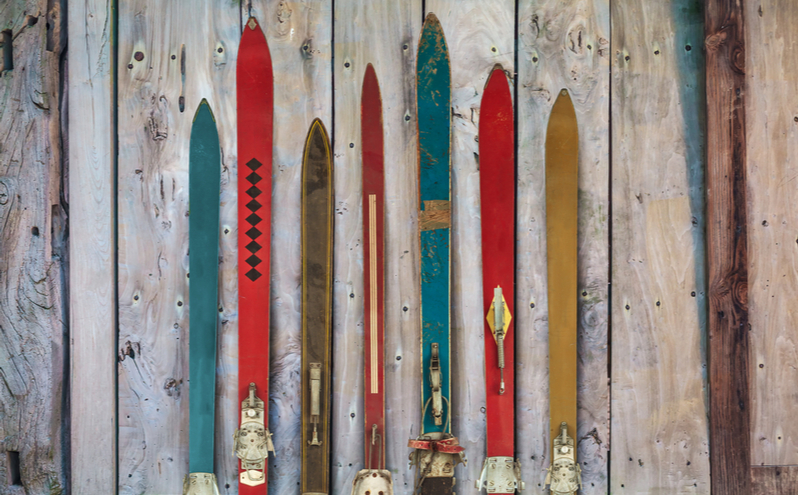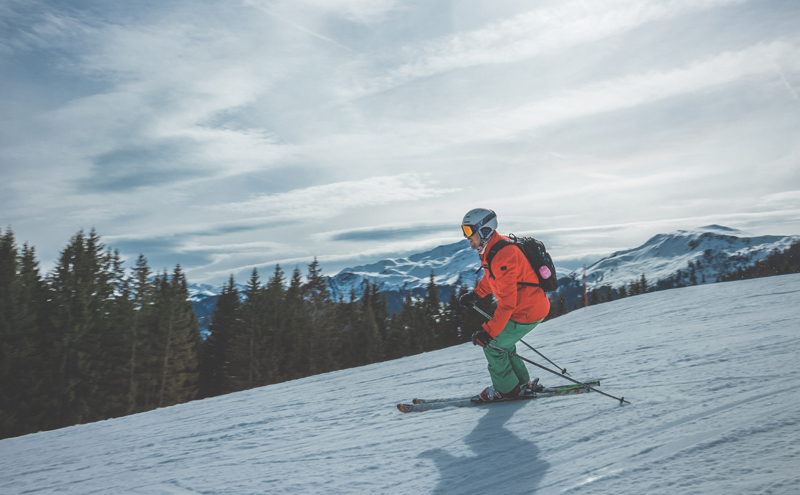You can expect an average pair of skis to weigh about 10 to 15 pounds (4.5 to 6.8 kg).
With all the different shapes and sizes available, generally, the larger and longer the skis are, the heavier they will weigh. The materials used for construction will also affect the weight of the skis.
Modern skis weigh much less than the older style of skis due to their material strength. Nowadays lighter skis can be made that still hold enough flex strength and stiffness. These same technological improvements carry over to all other skiing equipment such as ski jackets and poles which make it less tiring for skiers to go longer distances and hike uphill.
7 Example Ski Weights
The following chart features example ski weights of specific models ranging from the lightest to heaviest based upon weight. Additional details can be found on the manufacturer’s websites. Here’s the ski weight chart:
| Skis Model | Construction/Material | Length | Weight |
| Lib Tech Ufo 115 | Fiberglass/Sandwich | 175 cm | 8.5 lbs (3.9 kg) |
| K2 Mindbender 99Ti | Carbon/ABS | 177 cm | 9.3 lbs (4.2 kg) |
| J skis Metal Shuksan | Titanal/Metal | 173 cm | 9.6 lbs (4.4 kg) |
| Rossignol Sassy 7 | Wood/Fiberglass | 160 cm | 10 lbs (4.5 kg) |
| Nordica Enforcer | Sandwich | 172 cm | 10.6 lbs (4.8 kg) |
| Salomon XDR 84 Ti | Wood/Metal – Sidewall | 179 cm | 13 lbs (5.9 kg) |
| Surface Save Life Skis | Clear/Wood | 176 cm | 16 lbs (7.3 kg) |
What Types of Materials Are Used For Skis?
Across the various options available, each pair of skis are built from different materials that affect their overall weight. Here are the most common types of construction used to make skis.
Fiberglass
The most common material you’ll find on a pair of skis is fiberglass. This absorbs the shock and vibrations for a much smoother ride on hard-packed snow, and at a more affordable price point than most carbon fiber skis. For additional stiffness, they also contain a wooden core.
Carbon Fiber
Lightweight, hard, and durable—carbon fiber skis are built strong with a high stiffness while remaining light. The composite laminate runs in layers from tip to tail of the skis. While it’s lighter and more expensive, it can suffer from chattering at high speeds.
Titanal/Metal
Titanal or metal material is typically used as a reinforcement on the exterior of the skis. These titanal metal laminates are designed for expert skiers that need the increased torsional stiffness (making it easier to take sharp turns).
Sandwich
Sandwich style construction utilizes ABS plastics or P-tex that’s placed on either side of the core and above the edges. This type tends to be a bit more expensive and heavier than alternative options.
Wood

Most skis feature a wooden core for a solid structure. However, entirely wooden skis are difficult to find as they’re mainly used for vintage home decor or museums in this day and age.
With that said, there are a few companies that offer modern wooden skis with lightweight construction.
Why Use A Lighter Ski?
The lighter the better when it comes to skis. This makes it much easier to carry and transport your skis around the resort and to and from the gondola. With less physical strain getting your skis up the slopes, the more energy you have to actually ski.
In addition, lighter skis also traverse the powdery snow much better.
To Conclude
You can either wear your skis or carry them when going uphill. It’s easier to carry them long distances when they’re tied in one place. One of the best inventions to “lighten the load” and make it easier to carry the weight is to use a ski strap and pole carrier such as this one:
Any way you slice it, skiing manufacturers are constantly working to get the weight down to the perfect ratio for lighter and smoother rides.


